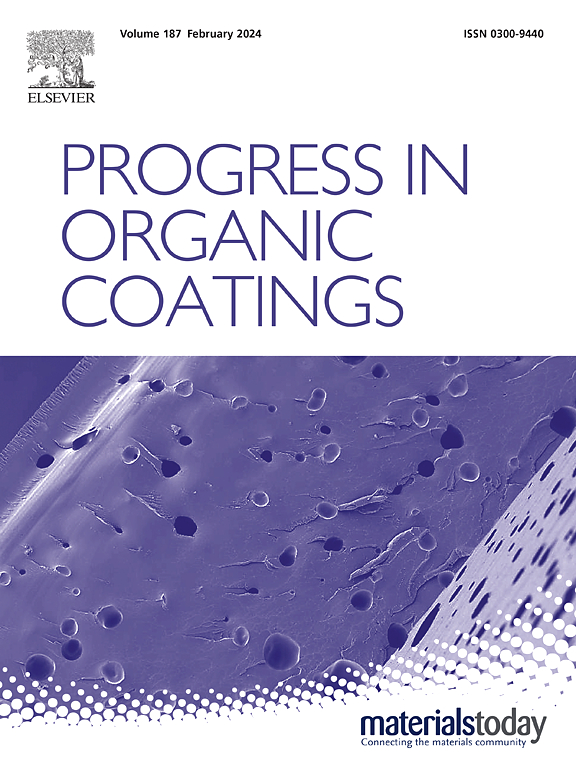IF 6.5
2区 材料科学
Q1 CHEMISTRY, APPLIED
引用次数: 0
摘要
我们展示了将纤维素纳米晶体(CNCs)和基于三甲基壳聚糖(TMC)的颗粒结合在一起的新型水性纳米涂层,可用于多功能纸张涂层。CNC 是通过硫酸水解布袋莲纤维素制备的。TMC 颗粒是通过可见光诱导的无表面活性剂乳液聚合绿色工艺生产的。通过原位聚合获得了表面功能化的 TMC 粒子。这些功能化 TMC 粒子可以设计成不同的内核类型(聚合物、油和空心)和外壳类型(阴离子、阳离子和非离子聚合物),每种类型都具有独特的性质和功能。值得注意的是,这些中空颗粒具有热膨胀性外壳和中空内核,可作为封装活性化合物(如富勒烯 C60,一种用于紫外线防护的模型分子)的容器。此外,研究人员还采用逐层刷涂技术,将 CNC、TMC 粒子和功能化粒子的水性分散体涂在多层纸张上。该研究的一个重点是 TMC 的多功能性,TMC 可用作稳定种子颗粒的稳定剂、氧化还原引发剂体系(如核黄素/叔胺和过氧化氢叔丁酯/伯胺)中的辅助引发剂,以及静电吸引阴离子分子(包括阴离子单体、数控系统和纸张表面)的阳离子模板。涂布纸具有防水性、更强的机械强度和防紫外线功能。本文章由计算机程序翻译,如有差异,请以英文原文为准。

Waterborne multilayer coatings from cellulose nanocrystals and trimethyl chitosan-based particles for potential protective coating
We demonstrate novel waterborne nanocoatings by combining cellulose nanocrystals (CNCs) and trimethyl chitosan (TMC)-based particles for multifunctional paper coating applications. CNCs were prepared through sulfuric acid hydrolysis of water hyacinth cellulose. TMC particles were produced through a green process using visible-light-induced surfactant-free emulsion polymerization. Surface-functionalized TMC particles were obtained through in-situ polymerization. These functionalized TMC particles can be designed with different core types (polymer, oil, and hollow) and shell types (anionic, cationic, and non-ionic polymers), each offering unique properties and functionalities. Notably, these hollow particles exhibited thermoresponsive shells and hollow cores, serving as reservoirs for encapsulating active compounds, such as fullerene C60, a model molecule for UV protection. Additionally, multilayer paper coatings were created using a layer-by-layer brush coating technique, incorporating aqueous dispersions of CNCs, TMC particles, and functionalized particles. A key focus of the study was the multifunctionality of TMC, which serves as a stabilizer for seed particle stabilization, a co-initiator in redox initiator systems (such as riboflavin/tertiary amine and t-butyl hydroperoxide/primary amine), and a cationic template for electrostatically attracting anionic molecules, including anionic monomers, CNCs, and the paper surface. The coated paper exhibited water resistance, enhanced mechanical strength, and UV–visible protection.
求助全文
通过发布文献求助,成功后即可免费获取论文全文。
去求助
来源期刊

Progress in Organic Coatings
工程技术-材料科学:膜
CiteScore
11.40
自引率
15.20%
发文量
577
审稿时长
48 days
期刊介绍:
The aim of this international journal is to analyse and publicise the progress and current state of knowledge in the field of organic coatings and related materials. The Editors and the Editorial Board members will solicit both review and research papers from academic and industrial scientists who are actively engaged in research and development or, in the case of review papers, have extensive experience in the subject to be reviewed. Unsolicited manuscripts will be accepted if they meet the journal''s requirements. The journal publishes papers dealing with such subjects as:
• Chemical, physical and technological properties of organic coatings and related materials
• Problems and methods of preparation, manufacture and application of these materials
• Performance, testing and analysis.
 求助内容:
求助内容: 应助结果提醒方式:
应助结果提醒方式:


